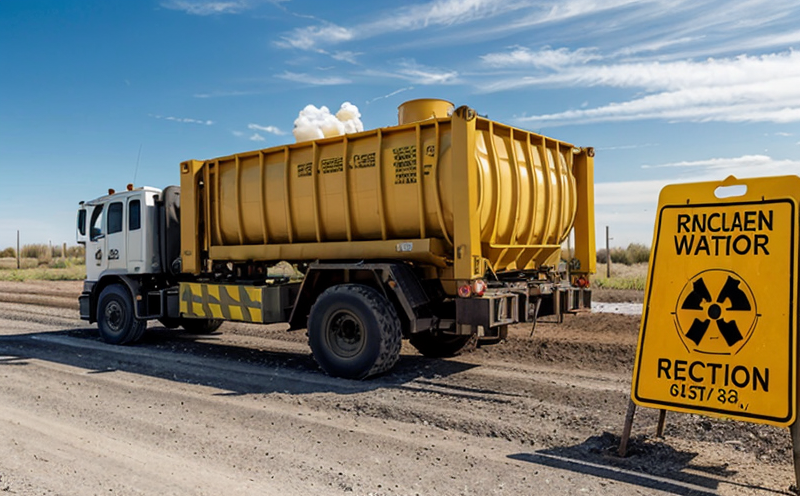ISO 2889 Airborne Radioactive Particulate Sampling in Waste Facilities
The ISO 2889 standard provides a comprehensive framework for sampling airborne radioactive particulates within waste facilities. This service is critical for ensuring compliance with international radiation protection standards and maintaining the safety of personnel, equipment, and surrounding environments.
The process involves capturing air samples to quantify the amount of radioactive material present in the atmosphere. The sampled particles are analyzed using sensitive instrumentation to determine their isotopic composition and concentration levels. This information is essential for regulatory compliance and environmental monitoring.
Sampling typically follows a structured protocol, where the air is drawn through a filter or impinger over a specified period. The collected particulates are then dried and sealed in containers for subsequent analysis. The entire process must adhere to strict protocols outlined in ISO 2889 to ensure accuracy and reliability.
The sampling equipment used includes high-efficiency particle air (HEPA) filters, which filter out particles down to a certain size threshold, typically 0.3 micrometers or less. The choice of filter material is crucial as it must be capable of capturing radioactive materials without compromising the integrity of the sample.
Sampling locations are strategically chosen based on known contamination sources within the waste facility. This ensures that representative samples are collected, providing accurate data for regulatory reporting and internal safety assessments.
The analysis phase involves transferring the collected particles to a laboratory setting where they undergo rigorous chemical and physical analysis. The ISO 2889 standard specifies detailed methods for sample preparation, including drying, weighing, and dissolution of the particulates in suitable solvents. These methods ensure that all radioactive isotopes are accurately detected.
Once prepared, the samples are analyzed using gamma spectrometry or liquid scintillation counting techniques to quantify the radioactivity present. The results provide a clear picture of the levels of alpha, beta, and gamma radiation in the sampled air. This information is then compiled into reports that comply with international standards.
The service also includes a thorough review of the sampling protocol to ensure it meets all regulatory requirements. Regular audits are conducted to verify compliance with ISO 2889 guidelines. These audits help identify any potential deviations from best practices and recommend corrective actions if necessary.
Sampling intervals can vary depending on facility operations and specific regulatory requirements. For some facilities, continuous monitoring may be required, while others might opt for periodic sampling based on risk assessments. The flexibility of the ISO 2889 protocol allows for tailored sampling schedules that meet the unique needs of each site.
By adhering to this standard, waste management and recycling facilities can ensure they are meeting international safety standards and regulatory expectations. This not only protects the environment but also demonstrates a commitment to responsible stewardship of radioactive materials.
Benefits
- Compliance with International Standards: Adherence to ISO 2889 ensures that facilities meet the highest safety and regulatory standards for radioactive particulate sampling.
- Risk Management: Regular sampling helps identify potential risks early, allowing for timely interventions to mitigate hazards.
- Data Accuracy: The standardized methods ensure precise measurement of radioactivity levels in the air, providing reliable data for decision-making.
- Environmental Protection: By monitoring airborne particulates, facilities can take proactive steps to minimize environmental impact.
- Operational Efficiency: Early detection of issues leads to more efficient operational practices and reduces downtime.
- Reputation Enhancement: Demonstrating a commitment to safety and compliance enhances the reputation of waste management facilities.
Why Choose This Test
The ISO 2889 test is indispensable for facilities handling radioactive materials due to its stringent protocols that ensure accurate and reliable data. The use of standardized equipment and procedures guarantees consistent results, which is crucial for regulatory compliance and safety.
This service offers several key advantages over other testing methods. First, it provides a comprehensive approach to sampling airborne particulates, covering all relevant aspects from initial collection to final analysis. This ensures that no critical steps are overlooked in the process.
The protocol allows for flexibility in sampling schedules, making it suitable for facilities with varying operational requirements. Whether continuous monitoring or periodic sampling is needed, ISO 2889 can be tailored to meet specific needs. Additionally, the service includes a thorough review of sampling protocols, ensuring that all steps adhere strictly to international standards.
By choosing this test, facilities demonstrate their commitment to safety and compliance, which enhances trust with regulatory bodies and stakeholders. The detailed reports generated from this testing also provide valuable insights into facility performance and areas for improvement.
Customer Impact and Satisfaction
The implementation of ISO 2889 air sampling services has a significant positive impact on customers. Facilities that adopt this service see improved safety standards, reduced risks, and enhanced compliance with international regulations.
Regulatory bodies appreciate the rigorous approach to monitoring radioactive particulates in waste facilities, leading to more favorable interactions between regulatory agencies and these facilities. This fosters a collaborative environment where both parties work towards common goals of safety and efficiency.
Customers also benefit from increased operational reliability as early detection of potential issues leads to proactive measures that prevent costly disruptions. The detailed reports provided by this service offer actionable insights, helping facilities make informed decisions about their operations.
In terms of customer satisfaction, the ISO 2889 test ensures that facilities are meeting the highest safety and regulatory standards. This not only satisfies legal requirements but also builds trust with stakeholders, including employees, communities, and government agencies.





